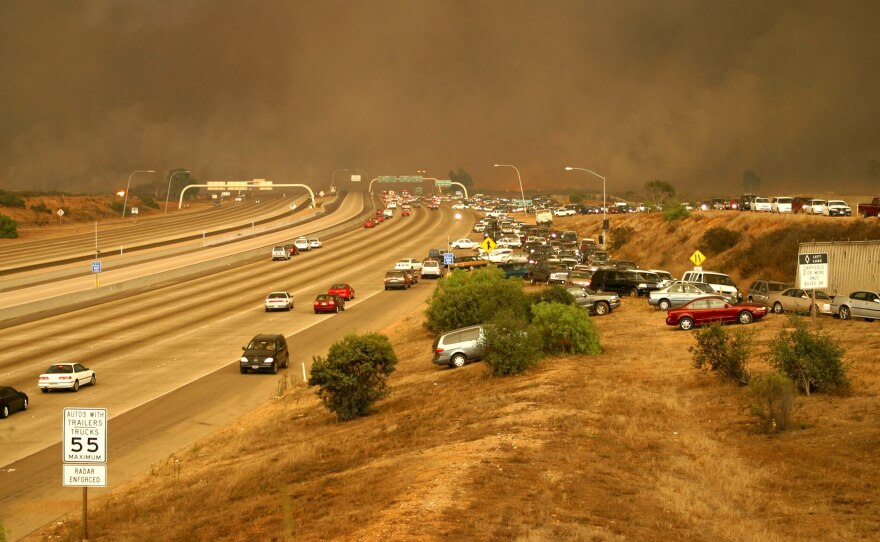In the early evening of Oct. 25, 2003, a hunter lost in the Cleveland National Forest about 25 miles east of San Diego started a small campfire as a signal to searchers. He soon lost control of the fire and Santa Ana winds turned it into the Cedar Fire — at the time, the largest wildfire in California history.
During that Saturday night and into Sunday morning, the fire roared over the Cuyamaca Mountains toward the city limits. It engulfed the area around Wildcat Canyon Road, near Lakeside, and took the lives of 12 people.
At the time, no warning system was in place to alert residents to get out. There was also a restriction preventing firefighting aircraft from dropping water or retardant within half an hour to sunset. The first report of the fire came in at 5:35 p.m. — sunset was 6:05 p.m.
Over the next four days, the fire burned 427 square miles, cutting a path 30 miles across. It destroyed much of the community of Crest, jumped Interstate 15 and tore through Scripps Ranch and Tierrasanta. In all, 15 people were killed and more than 2,800 homes and businesses were lost.

Scripps Ranch resident Jerry Lowthers was up early on that Sunday morning, intending to play in a softball game. When he saw the pitch-black sky, Lowthers woke his wife, and they quickly threw some essentials in their cars and drove off.
“I told my wife I’d meet her at Starbucks or something in Scripps Ranch, just as a place to rally, to connect,” Lowthers said. “That’s what we did, and an hour later everything was gone.”
One of the local television stations had set up to report on the fire across the street from their house, and as they sat in the coffee shop, Lowthers watched his house burn. “I told my wife it was the house down the block, I didn’t want her to be any more distraught than she was, but eventually, of course she knew.”
San Diego Fire-Rescue Fire Chief Colin Stowell was a young captain in 2003 and was in one of the first strike teams sent to Scripps Ranch.
“I was right in the middle of it, with our strike team there,” Stowell says. “There was no amount of fire engines or personnel that was going to stop that firestorm from blowing through those communities.”
When the Lowthers were allowed back into their neighborhood, Jerry Lowther said it was like being in a war zone.
“All up and down Fairbrook Road right here, I don’t know, 40 houses went away,” he said. “And in all Scripps, I think 235 houses went away.”
Lessons learned
The Cedar Fire taught some hard lessons and brought many improvements to the fire departments that faced it. San Diego had off-duty firefighters ready to work but did not have enough fire engines and vehicles to get them to the front lines.
“We are in a much better position today,” Stowell said. “We have a healthy reserve fleet, we have utility vehicles, and we have ways to get them out that certainly would make a big difference today.”
Communication was also a problem. As help arrived from other departments in the county and around the state, multiple radio systems were in play. Some had UHF radios, and others had VHF, meaning they could not talk to each other.
Those problems have since been solved, CalFire Battalion Chief Tony Mecham said.
“I think San Diego probably operates with the greatest collaboration of anywhere,” he said. “As fire chiefs we meet monthly. We have working groups, whether it be training, communications. We’re constantly talking.”
San Diego city and county, CalFire and San Diego Gas & Electric (SDG&E) have expanded their aerial fleets and collectively now have nearly five times as many firefighting helicopters and planes as were available in 2003. There are also agreements in place with the military to call upon their helicopters if needed.
New rules
The rule regarding dropping water and retardant from the air was rescinded. There is now mapping software that lets the incident commanders see a fire in real-time and where it will be in the next hour, eight hours or 24 hours. Anyone can now go online and monitor wind patterns and other conditions.
The city’s building codes were also reformed. Many houses were lost in the Cedar Fire because embers flew ahead of the firestorm, got lodged in the eaves and burned the roof. Scripps Ranch was once distinctive for its shake-shingle roofs. Those are no longer allowed and newly built homes cannot have exposed eaves.
Residents are regularly reminded to “fire harden” their homes. Create defensible space. If there’s firewood, patio furniture or anything that can burn, the advice is to get it away from the house. Several homes were destroyed by the fire because the firewood next to the homes caught fire.
All of this was done in the hope that when (not if) the next major wildfire hits San Diego County, residents won’t suffer like they did in 2003.







